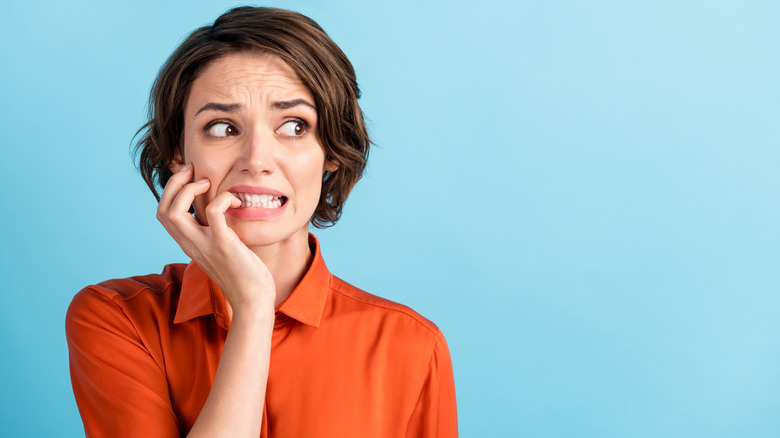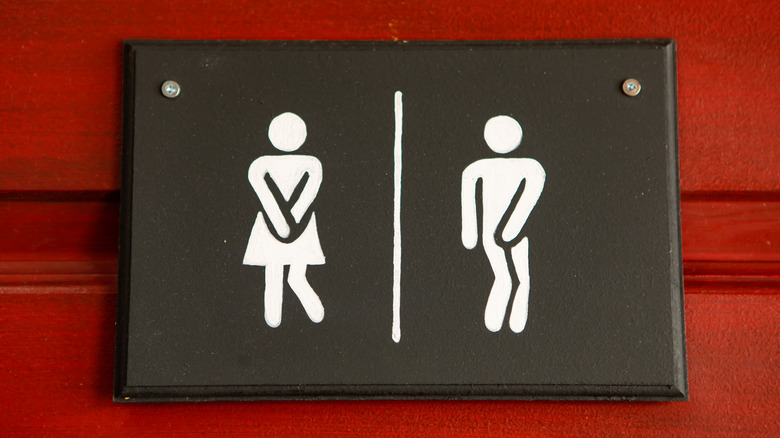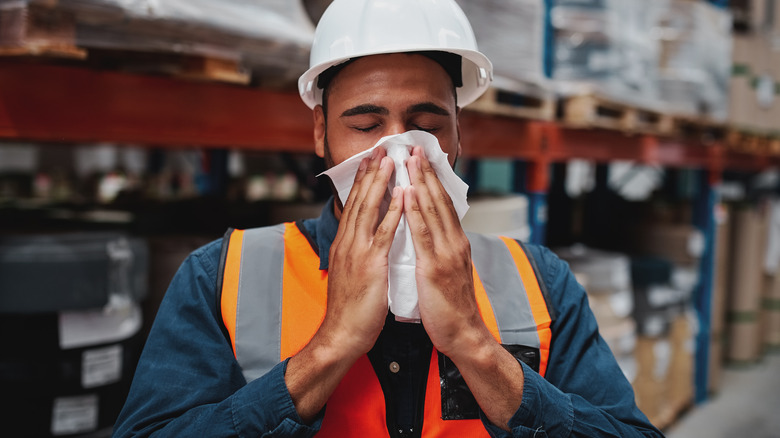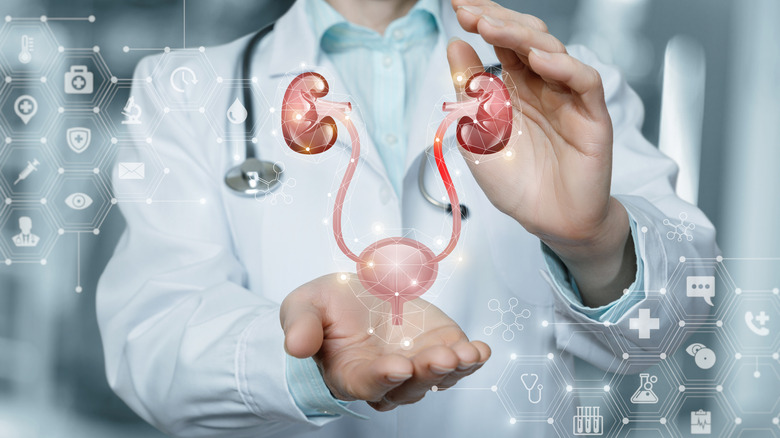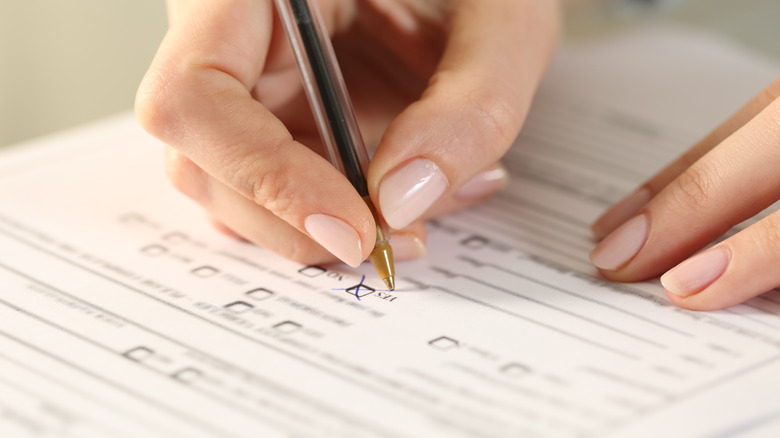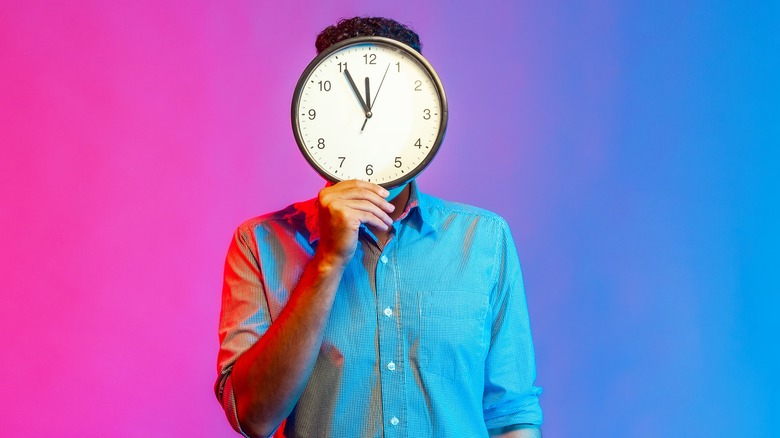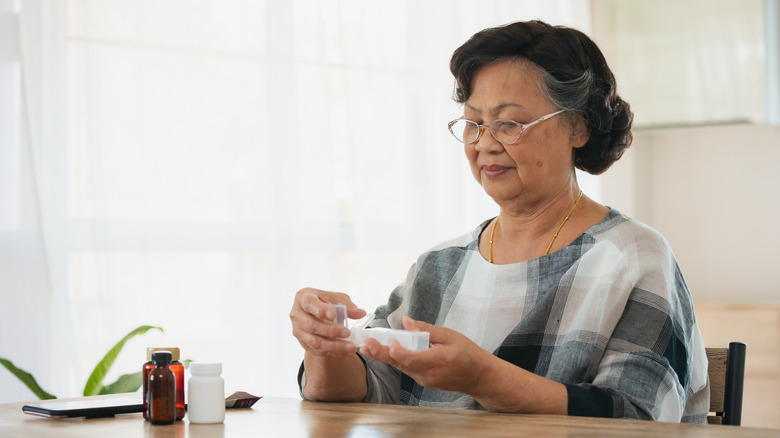What To Know About An Overactive Bladder
If you've got an overactive bladder (OAB), or think you might, it may seem like you're the only person dealing with this embarrassing (and exhausting) problem. But think again. Just like you probably aren't shouting your symptoms from the rooftops, about 30% of men and 40% of women in the United States have OAB symptoms (via Urology Care Foundation). And many are struggling with the condition in silence.
Overactive bladder is characterized by the urgent need to urinate many times, day or night, sending you rushing to the bathroom whether you're busy at work, exercising, socializing with friends, having sex, or trying to catch some ZZZs. Fear of getting too far from a bathroom, or leaking urine, tends to lead people to stay at home and isolate themselves, and that becomes a slippery slope toward depression.
In addition, many people don't get medical help for the condition — even if they do, many doctors aren't well versed on the problem (via the Current Urology). Quite the perfect storm, isn't it? Here's what you should know about an overactive bladder.
Debunking myths about overactive bladder
Perhaps because overactive bladder isn't a commonly discussed topic, myths and assumptions abound about who gets the condition, what causes it, and how you can minimize the problem. Let's get the truth directly from the experts.
Myth: OAB is just part of getting older. Nope. Toss that one out the window, although the truth isn't overly comforting either (via Associated Urological Specialists). OAB affects about 17% of women between the ages of 18 and 40. And while OAB becomes more common as you get older, it's not a normal part of aging. Here's another myth: Limiting fluids will help the problem. Wrong again. Less urine can irritate your bladder and lead to bacterial growth. And concentrated urine can actually increase your need to urinate.
And how about this myth: OAB requires a surgical solution. Actually, there are numerous ways to improve overactive bladder, and surgery is often saved as a last resort for severe cases. And this one: Stopping at the bathroom extra times, just in case, is helpful. You're already weary of going to the toilet all the time, says Healthgrades. Why add extra trips? Besides, the goal is to get your bladder accustomed to holding urine longer, if possible, and needing fewer bathroom stops. No need to head in the opposite direction.
Myth: Only women have this problem. Men are less likely to get medical help for overactive bladder, but starting around age 60, more men have the condition than women.
How to recognize overactive bladder
Are you needing to urinate more often than you used to? Frequency of urination is a common symptom of overactive bladder, according to the Cleveland Clinic. And so is urinary urgency, where you've got to go now, with very little advance warning. You also might leak urine when you get the urge, a symptom called urge incontinence. And then there's nocturia, which is the need to use the bathroom two or more times at night.
Needing to urinate eight or more times in 24 hours is the broad definition of OAB (via the National Association for Continence), and you may get the urge to go even if you've visited the bathroom quite recently. Hearing running water triggers the urge in some people, and discomfort during urination and bed-wetting are other possible symptoms, notes Medical News Today.
Symptoms differ between men and women, due to anatomical differences. For example, women may have more problems with storage of urine, while men may have more issues around releasing urine.
Symptoms that aren't signs of overactive bladder
Leaking urine when you sneeze, cough, or laugh, or even when you stand up, walk, or bend over, are symptoms of stress urinary incontinence (SUI), not OAB, according to Medical News Today. SUI is not associated with an urgency to urinate, or frequency of urination, and people with SUI usually only leak a small amount of urine at a time.
A urinary tract infection (UTI) is a different condition too (via Advanced Gynecology). This one is especially confusing though, because both conditions can cause a frequent and urgent need to urinate. In fact, a study published in Current Urology Report found that OAB is often misdiagnosed as a UTI, and that a urine culture is needed to differentiate the two.
Onset of symptoms also may help you tell the difference, because UTIs generally develop quickly, with acute symptoms, while OAB is more ongoing and chronic. Pain is another tipoff, continues Advanced Gynecology. A burning sensation or pain while urinating is common with a UTI, but not with OAB. And a UTI can cause bloody or cloudy urine, while an OAB does not.
Another condition with similar symptoms is benign prostatic hyperplasia (BPH), or prostate gland enlargement (via the Mayo Clinic). Differences include difficulty starting the flow of urine, or a flow that is weak or intermittent. Dribbling as you finish urinating can also be a symptom of BPH.
Risk factors that contribute to overactive bladder
Overactive bladder is caused by the malfunction of the detrusor muscle, the three-layered muscular wall of the bladder, and that malfunction may be caused by a variety of factors (per Cedars-Sinai).
Neurological conditions such as Parkinson's disease, multiple sclerosis, and stroke are linked to OAB, as well as nerve damage caused by pelvic or abdominal trauma or surgery. Bladder stones, formed by minerals that build up in the bladder, can also contribute to OAB symptoms, and are most common among men.
Bladder and prostate cancer can cause OAB, along with normal pressure hydrocephalus (via Johns Hopkins Medicine), which is when too much fluid builds up in the chambers of the brain.
Side effects of medications — antidepressants, sedatives, ACE inhibitors, calcium channel blockers, NSAIDS, and other analgesics — are also linked to overactive bladder (per Cancer Therapy Advisor). Race is a factor as well. In men, OAB affects 33% of African Americans, 28% of Hispanics, 27% of Asians, and 26% of whites. In women, the percentages are almost 46% African American, 43% white, 42% Hispanic, and almost 27% Asian.
How a normal bladder works
Picture your bladder as looking and acting like a balloon, explains Your Pelvic Floor. Urine comes out of your kidneys and goes into your bladder through tubes called ureters. As more urine flows in, the walls of your bladder stretch, and a valve called the urethral sphincter keeps it there, with help from the pelvic floor muscles. The valve and muscles keep urine from leaking when you cough or laugh, and also give you time to get to a bathroom once you start feeling the urge to go. Once you've reached a toilet, your brain kicks in to tell the valve and pelvic floor muscles to relax and the bladder to empty.
Cxbladder adds that a normal bladder synchronizes neurologic, musculoskeletal, and psychological cues to coordinate the filling, storing, relaxing, and emptying of urine. Even more amazing, the muscles of your bladder thicken when the organ is empty, and become thin as your bladder fills.
Causes of overactive bladder
Giving birth to a baby is one possible cause of overactive bladder, because it can weaken and stretch the muscles in your lower abdomen (per the Cleveland Clinic). The result can be a drooping bladder and leakage of urine.
A variety of other experiences, as well as diseases, can contribute to OAB. Going through radiation, or having back or pelvic surgery, can lead to the problem, or having a stroke, herniated disc, multiple sclerosis, or Parkinson's disease.
Malfunctioning of nerves that send messages to your bladder is another possible cause of the problem (via Urology Care Foundation). For example, your nerves might be signaling your bladder that it needs to be emptied when it really doesn't, and your bladder might be sending false messages back, explains the Urinary Incontinence & Female Urology. In most cases, the person doesn't have an identifiable neurological problem, but the nerves are acting up anyway.
Prostate enlargement, which causes blockage of urine, can cause OAB in men, and pelvic organ prolapse, or surgical treatment of stress urinary incontinence, may cause urine blockage and OAB in women.
Children can have overactive bladders too
You may associate overactive bladder with adults, but children also have this condition (via Medical News Today). While bedwetting is pretty common among very young children, OAB may be suspected if urinary incontinence persists during the day after about age three, and during the night after around age four. Interrupted sleep and needing to use the toilet frequently — and possibly in a big hurry — are other signs. In fact, a child may not make it to the bathroom in time, explains WebMD.
The cause of OAB in kids may be related to uncontrollable spasms in their bladder muscles. Those muscles are designed to keep urine in check, but they may fail if the bladder is experiencing contractions.
Children also get urinary tract infections, which can contribute to OAB, and there's a condition called pollakiuria, which can cause very frequent urination, like every five to 10 minutes, but just while the child is awake. It may be related to stress, and symptoms usually go away in a few weeks.
Caffeine and allergic reactions can also trigger an overactive bladder, continues Medical News Today, and even bladder wall irritation, brought on by urinating too often.
How the problem is diagnosed
According to Cedars-Sinai, determining if you have an overactive bladder may begin with your doctor asking you to fill out a screening questionnaire and share your medical history. A complete physical exam may come next, and a urinalysis to check for bacteria, blood, puss, or excess protein in your urine. A cough stress test may be done to measure your urine loss, and a neurological check to identify any sensory issues that may be contributing to the problem.
If additional tests are needed for diagnosis, your provider may recommend urodynamic tests to analyze how your bladder is functioning (via the Mayo Clinic). These tests help identify how well your bladder empties and how much urine is left in your bladder after you've urinated. A device called a uroflowmeter may be used to collect and measure your urine and graph the changes in your flow rate.
Bladder pressure can also be tested through cystometry, which involves a catheter slowly filling your bladder with warm fluid and a sensor gauging how much pressure your bladder needs to exert to empty completely.
Dear diary – bladder diary, that is
One way to gather details about overactive bladder is to keep a bladder diary, recording day-to-day details of your "gotta go" issues, notes Urology Care Foundation. How much fluid are you drinking, and what times of day are you drinking? How often and how much are you urinating? What are the circumstances around each of your urgency sensations — and if leaking urine, how much?
News Medical Life Sciences goes into even greater detail about what to include in your bladder diary. Measure your fluid intake in ounces, milliliters, or cups. And note what you drank — including soups and broth, as well as foods like ice cream or sherbet that melt at room temperature.
Also record what you were doing at the time you felt the urge to urinate (or suddenly leaked). Were you coughing, sneezing, or lifting something heavy? Did you suddenly void without any warning, or were you able to get to the bathroom in time?
Be consistent and thorough at keeping your bladder diary — avoid filling in the log by memory if you forget to keep up with it for a day or two. Three to seven days of tracking should be plenty to collect the details your doctor may need to evaluate the issue.
Lifestyle changes may help
Making some changes in your daily life can sometimes minimize or curb overactive bladder, and it's certainly worth a try.
Let's start with one thing you may want to cut back on: Caffeine (per Urinary Incontinence & Female Urology). Beverages such as coffee, tea, cola, and energy drinks that contain caffeine are known to irritate the bladder, so try to reduce your intake to one or two cups a day. Eliminating alcohol can also greatly reduce symptoms (via WebMD).
Eating less salt is another lifestyle change that may help, according to a recent study from Scientific Reports (via Renal & Urology News). Quitting smoking is a good idea too. The study explains that nonsmokers have a lower instance of urgent OAB than smokers.
As for something you can eat more of? Choose fiber. Constipation can contribute to OAB, and eating foods like broccoli, Brussels sprouts, oats, lentils, quinoa, apples, and pears will increase the regularity of your bowel movements and help you to possibly avoid that problem, according to Renal & Urology News.
Pelvic floor exercises, including kegel exercises, can help strengthen and tighten the muscles that control bladder leakage and urgency, according to the National Association for Continence. And, while kegel exercises have long been thought of as just for women, men (especially older men) can benefit from them too (per Harvard Health Publishing). Stronger pelvic floor muscles may even help improve erection problems.
Behavioral therapy helps some people with overactive bladder
Once you've learned to tighten your pelvic floor muscles with kegel exercises, see if you can train your bladder to wait a little longer when you get the urge to urinate, explains the Mayo Clinic. Start with a short delay of about 30 minutes, and gradually increase the amount of time you can wait. Emptying your bladder every three or four hours is a good goal to aim for.
You can also go to the toilet at scheduled times every day (again, every two or four hours) which trains your bladder to hold the urine longer. There's also biofeedback, where electrical sensors attached to your body help you learn to detect subtle changes in your bladder, tighten your pelvic muscles, and control the sense of urgency.
Double voiding, where you urinate and then wait a few seconds before urinating again, is one way to help your bladder empty as fully as possible before you leave the bathroom (via Everyday Health).
Medical treatments for overactive bladders
If behavioral techniques aren't effective at managing your overactive bladder, your doctor may prescribe medications that control muscle spasms in the bladder (via the Cleveland Clinic). Oxybutynin (Ditropan), Tolterodine (Detrol), and Fesoterodine (Toviaz) are a few of the options. Mirabegron (Myrbetriq), a beta-3 adrenergic medication, is another option — it relaxes the bladder muscles to increase its capacity, explains Medline Plus. Be sure to ask your doctor about the benefits and risks of taking any medications that are prescribed.
Posterior tibial nerve stimulation is another approach that involves stimulating the tibial nerve at the ankle, which sends signals up to the bladder to help control OAB (per UCLA Health). And Botox injections into your bladder muscle may also have good results.
Sacral nerve stimulation is another treatment option that involves implanting a neurotransmitter above the buttock, continues the Cleveland Clinic. The device sends signals to the bladder through a wire near the sacral nerve and can reduce the number of times you leak urine or need to urinate.
If overactive bladder persists after you've tried every other option, major reconstructive surgery of the urinary tract may be recommended, but it's only necessary in rare cases.

